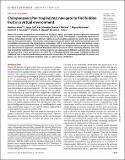Files in this item
Chimpanzees (Pan troglodytes) navigate to find hidden fruit in a virtual environment
Item metadata
| dc.contributor.author | Allritz, Matthias | |
| dc.contributor.author | Call, Josep | |
| dc.contributor.author | Schweller, Ken | |
| dc.contributor.author | McEwen, Emma S. | |
| dc.contributor.author | de Guinea, Miguel | |
| dc.contributor.author | Janmaat, Karline R. L. | |
| dc.contributor.author | Menzel, Charles R. | |
| dc.contributor.author | Dolins, Francine L. | |
| dc.date.accessioned | 2022-07-07T13:30:07Z | |
| dc.date.available | 2022-07-07T13:30:07Z | |
| dc.date.issued | 2022-06-24 | |
| dc.identifier | 279528201 | |
| dc.identifier | 3a63476e-af5d-499d-9bc5-7ec57b211b54 | |
| dc.identifier | 85133101445 | |
| dc.identifier | 000818940000002 | |
| dc.identifier.citation | Allritz , M , Call , J , Schweller , K , McEwen , E S , de Guinea , M , Janmaat , K R L , Menzel , C R & Dolins , F L 2022 , ' Chimpanzees ( Pan troglodytes ) navigate to find hidden fruit in a virtual environment ' , Science Advances , vol. 8 , no. 25 . https://doi.org/10.1126/sciadv.abm4754 | en |
| dc.identifier.issn | 2375-2548 | |
| dc.identifier.other | ORCID: /0000-0002-8597-8336/work/115309331 | |
| dc.identifier.other | ORCID: /0000-0002-3886-0255/work/142499485 | |
| dc.identifier.uri | https://hdl.handle.net/10023/25618 | |
| dc.description | This work was supported by the European Research Council under the European Union’s Seventh Framework Program (FP7/2007-2013)/ERC grant agreement no. 609819, SOMICS and Templeton World Charity Foundation, grant ID: TWCF0314. | en |
| dc.description.abstract | Almost all animals navigate their environment to find food, shelter, and mates. Spatial cognition of nonhuman primates in large-scale environments is notoriously difficult to study. Field research is ecologically valid but controlling confounding variables can be difficult. Captive research enables experimental control, but space restrictions can limit generalizability. Virtual reality technology combines the best of both worlds by creating large-scale, controllable environments. We presented six chimpanzees with a semi naturalistic virtual environment, using a custom touch screen application. The chimpanzees exhibited signature behaviors reminiscent of real-life navigation: they learned to approach a landmark associated with the presence of fruit, improving efficiency over time; they located this landmark from novel starting locations, and approached a different landmark when necessary. We conclude that virtual environments can allow for standardized testing with higher ecological validity than traditional tests in captivity, and harbor great potential to contribute to longstanding questions in primate navigation, e.g., the use of landmarks, Euclidean maps, or spatial frames of reference. | |
| dc.format.extent | 16 | |
| dc.format.extent | 2893658 | |
| dc.language.iso | eng | |
| dc.relation.ispartof | Science Advances | en |
| dc.subject | BF Psychology | en |
| dc.subject | DAS | en |
| dc.subject.lcc | BF | en |
| dc.title | Chimpanzees (Pan troglodytes) navigate to find hidden fruit in a virtual environment | en |
| dc.type | Journal article | en |
| dc.contributor.sponsor | European Research Council | en |
| dc.contributor.institution | University of St Andrews. Centre for Social Learning & Cognitive Evolution | en |
| dc.contributor.institution | University of St Andrews. School of Psychology and Neuroscience | en |
| dc.contributor.institution | University of St Andrews. Institute of Behavioural and Neural Sciences | en |
| dc.identifier.doi | 10.1126/sciadv.abm4754 | |
| dc.description.status | Peer reviewed | en |
| dc.date.embargoedUntil | 2022-06-24 | |
| dc.identifier.grantnumber | 609819 | en |
This item appears in the following Collection(s)
Items in the St Andrews Research Repository are protected by copyright, with all rights reserved, unless otherwise indicated.

